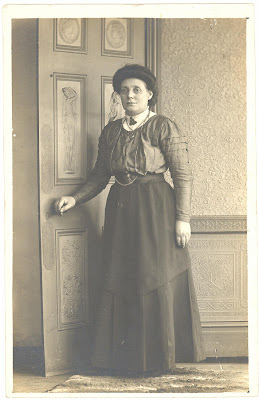Cordwainer, cobbler,
shoemaker, shoe repairer, and
currier were all occupations involving leather and many of my father's ancestors worked in these trades.
The picture on the left is my Dad, Herbert William Davies, in his shop on Johnson Street in Victoria.
William Duckworth, Dad's third great-grandfather, was born about 1767 in Halifax, Yorkshire. William's occupation was described as a shoemaker at the trial of his son, George Duckworth, in 1812. George, another, shoemaker, was tried and sentenced to transportation for an incident related to the Luddite movement in Yorkshire. William was listed as a cordwainer in the 1841 and 1851 census.
William Duckworth, Dad's second great-grandfather, was born in 1795 in Halifax. This William moved to Manchester about 1825, where he was listed as a labourer in 1841, a warehouseman in 1851, a shopkeeper in 1857, and finally a currier in 1861. A currier works with leather in the tanning process.
Dad's father, my grandfather, lost a leg in the first world war and was unable to take up his former occupation of electrician after the war, and after a failed attempt at farming, Grandpa learned the trade of shoe repairing from an army friend. William Duckworth Davies, born 1891 in Runcorn, Cheshire to John Davies and Hannah Duckworth, owned his own shoe repair shops in Edmonton and Victoria. Grandpa is pictured on the right in his shop in Edmonton, Alberta. My Dad, Bert Davies, left school after grade eight to join his father in the business and is pictured in the archway.

William Duckworth Davies and his wife, Lucy Crockett, moved to Victoria, British Columbia in 1934 and after failing at farming once more, he opened a shoe repair shop. His first shop was on Johnson Street, but he had moved to Fort Street before enticing my father to join him in the business in 1941. I remember Grandpa's shop on Fort Street with its black and white tile front. The building does not look much different today but the store is occupied by a Sushi restaurant. The picture was taken about 1950 with Jim Gillespie, an employee, on the left; Dad, Herbert William Davies in the middle; and Grandpa, William Duckworth Davies on the right.

Grandpa continued to operate his shop until her retired in 1961 at age 70. Dad left Davies and Son Shoe Repair and was employed at other shoe repair shops until he bought out his last employer, Geroge Inrig. Dad operated Arcadia Shoe Repair at various locations from the mid 50s until he retired in 1979. His first shop was on Broad Street, near Trounce Alley in Victoria where he had Roy Blevins as a partner. They moved to a larger shop on Yates Street before Dad had to buy his partner's interest in the business because the lacquers and other chemicals used in the shop were affecting Roy's health. The picture is of the Broad Street shop with Dad on the left, two employees, Marcel and Tony, in the middle, Dad's sister, Evelyn, behind Roy Blevins on the right.
I remember the Yates Street store because I used to spend time there on Saturdays before and after my piano lessons. I love the smell of the adhesives and dyes when I enter a shoe shop today because it reminds me of my youth. Dad became an expert at dying shoes to match any colour and he also covered shoes with fabric. My bridesmaids wore shoes to match their dresses at my wedding. He also took a course through Dr. Scholls to learn the anatomy of a foot and he was able to fit arch supports, bunion pads, and other foot-care products.
Dad moved to a one-man shop on Johnson Street about 1970 and moved again to Cook Street in the Fairfield district of Victoria in the mid 1970s. These small shops were more profitable because he did not have the payroll expenses.
I had the advantage, or disadvantage of having a shoe expert for a father. Dad always had a say on which shoes I could wear. They always fitted properly and they had to have leather uppers and insoles. My shoes were always well soled and well heeled and there is no truth to the saying that "a cobbler's daughter goes barefoot".
















